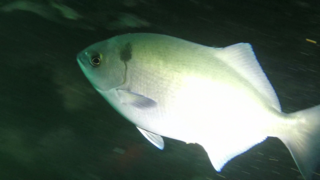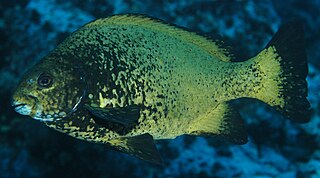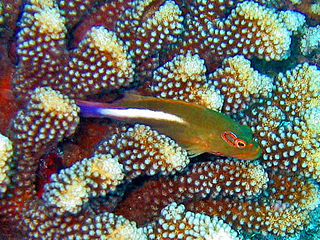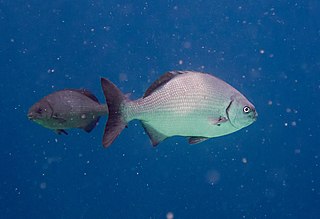
The halfmoon, also known as the blue perch, is a species of marine ray-finned fish, a sea chub from the subfamily Scorpidinae, part of the family Kyphosidae. It is native to the coasts of the eastern Pacific Ocean off western North America. It is fished for using hook and line and it is a desirable food fish.

The sea chubs, also known as rudderfish and pilot fish and in Hawaiian as enenue or nenue, are a family, Kyphosidae, of fishes in the order Perciformes native to the Atlantic, Indian and Pacific Oceans usually close to shore in marine waters.

Girella cyanea, also known as the blue drummer or Australian bluefish, is a species of sea chub native to inshore waters, around 6 metres (20 ft) depth, from Australia to New Zealand and the Kermadec Islands. Sightings were first recorded in 1881 but the species made its debut in scientific publications in 1919 in Theodore Roughly's Fishes of Australia and Their Technology.

The silver drummer, also known as the buff bream, buffalo bream, buffs, common buffalo bream, drummer bream, Southern silver drummer or Sydney drummer, is a species of marine ray-finned fish, a sea chub from the family Kyphosidae. It is found in the southeastern Indian Ocean and the southwestern Pacific Ocean off Australia and New Zealand where it is found in shallow water near rocky reefs.

The Microcanthinae, commonly known as footballers, mados, stripeys, and moonlighters, are a subfamily of the sea chubs, a family of marine ray-finned fish in the order Perciformes.

The arc-eye hawkfish, the ringeye hawkfish, horseshoe hawkfish or whiteline hawkfish, is a species of marine ray-finned fish, a hawkfish belonging to the family Cirrhitidae. It is found in shallow waters in the tropical Indo-Pacific on reefs, resting on coral heads much of the time.

The coral hawkfish, the pixy hawkfish or sharp-headed hawkfish, is a species of marine ray-finned fish, a hawkfish belonging to the family Cirrhitidae. It is native to tropical reefs of the Indian Ocean and the Pacific Ocean. It occasionally is found in the aquarium trade.

Kyphosus sectatrix, the Bermuda chub, Pacific drummer, beaked chub, grey drummer, Pacific chub or white chub, is a species of marine ray-finned fish, a sea chub from the family Kyphosidae. This species is found in tropical and subtropical coastal waters worldwide. It has had a confused taxonomic history dating back to Linnaeus's naming of the species in 1758.
The Gladius sea chub is a species of marine ray-finned fish, a sea chub in the family Kyphosidae. It was recognised a new species in 2013 and is found in the southeastern Indian Ocean where endemic to the southern coasts of Western Australia.

Kyphosus azureus, the zebra-perch sea chub, zebra perch or zebra sea chub, is a species of marine ray-finned fish, a sea chub from the family Kyphosidae which is native to the eastern Pacific Ocean coasts of North America.

Kyphosus is a genus of sea chubs native to the Atlantic, Indian and Pacific oceans. It is the only genus in the subfamily Kyphosinae of the family Kyphosidae.

Kyphosus elegans, the Chopa Mojonera or Cortez chub, is a species of marine ray-finned fish, a sea chub from the family Kyphosidae. It is found in the eastern Pacific Ocean where it is of minor importance to commercial fisheries.

Girella elevata, the rock blackfish, Eastern rock blackfish, black rockfish or Eastern rock blackfish drummer is a species of marine ray-finned fish, a sea chub from the family Kyphosidae. It is found in the southwestern Pacific Ocean around eastern Australia and northern New Zealand.

Girella zebra, also known as zebrafish or stripey bream, is a species of marine ray-finned fish, a sea chub in the family Kyphosidae. It lives in the Indo-Pacific, where it is endemic to the coastal waters of the southern parts of Australia.

Kyphosus bigibbus, the brown chub, grey drummer, darkfin drummer, insular rudderfish, grey chub, grey sea chub, southern drummer or topsail drummer is a species of marine ray-finned fish, a sea chub from the family Kyphosidae. It is a herbivorous species which is found in subtropical and tropical seas worldwide.

Kyphosus vaigiensis, the brassy chub, brassy drummer, long-finned drummer, low-finned drummer, Northern silver drummer, Queensland drummer, Southern drummer, blue-bronze sea chub, brassy rudderfish, yellow seachub, large-tailed drummer, low-finned chub or long-finned rudderfish, is a species of marine ray-finned fish, a sea chub from the family Kyphosidae. It is a largely herbivorous species which has a circumglobal distribution. Studies in the 21st Century appear to have shown that some other species in the genus Kyphosus are junior synonyms of this taxon.

Kyphosus cinerascens is a species of marine ray-finned fish. It is a sea chub from the family Kyphosidae. Kyphosus Cinerascens has 11 dorsal fins and 12 anal fins. Kyphosus cinerascens are widely distributed in the Indo-Pacific region. The Kyphosus cinerascens has a strict diet on phaeophytes, chlorophytes, and rhodophytes, making them herbivores.

Kyphosus cornelii, the Western buffalo bream, Cornel's drummer or the Western drummer, is a species of marine ray-finned fish, a sea chub belonging to the family Kyphosidae. It is endemic to Western Australia.

The Hawaiian chub, also known as the insular rudderfish or bicolor chub, is a species of marine ray-finned fish, a sea chub belonging to the family Kyphosidae. This species is found in the Central Pacific Ocean.

















